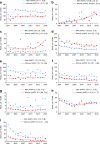Temporal trends in rates of infection-related hospitalisations in Hong Kong people with and without diabetes, 2001-2016: a retrospective study
- PMID: 32986145
- PMCID: PMC7520551
- DOI: 10.1007/s00125-020-05286-2
Temporal trends in rates of infection-related hospitalisations in Hong Kong people with and without diabetes, 2001-2016: a retrospective study
Abstract
Aims/hypothesis: Infection is an under-recognised but important complication in people with diabetes. Studies on temporal trends in incidence of infection in this population are limited. We report the trends in infection-related hospitalisation in people with diabetes and compared hospitalisation rates between people with and without diabetes in Hong Kong.
Methods: Hospital admissions with infection, including pneumonia, influenza, tuberculosis, kidney infection, urinary tract infection, cellulitis, osteomyelitis, foot infection and sepsis, listed as principal diagnosis occurring between 2001 and 2016 were identified from people with diabetes in the electronic medical record system of the Hong Kong Hospital Authority. Data on hospitalisation for a subset of these infections in the general population between 2007 and 2016 were obtained from the Department of Health. The number of people with diabetes ranged between 117,322 in 2001 and 570,929 in 2016, and the number without diabetes ranged between 5,242,614 in 2007 and 5,593,153 in 2016. Joinpoint regression was used to describe the trends.
Results: In people with diabetes, over a period of 16 years, the age-standardised annual rates of hospitalisation decreased for tuberculosis but increased for influenza; rates of hospitalisation for pneumonia increased up until 2004/2005 and declined in men and stabilised in women. The rates of hospitalisation for most infection types were unchanged or increased in the 20-44 year and 45-64 year age groups and decreased in those aged 65 years or above. Trends for most of the infections were similar when comparing sexes. Between 2007 and 2016, the rate ratios of hospitalisation for most infection types between people with and without diabetes were stable, and the rate ratios remained higher in people with diabetes, ranging from 1.3-1.4 for pneumonia to 3.2-4.9 for kidney infections in 2016 compared with non-diabetic individuals.
Conclusions/interpretation: Despite advances in medical care, hospitalisation due to infections remains a major healthcare burden in people with diabetes. Graphical abstract.
Keywords: Cellulitis; Diabetes; Hospitalisation; Infection; Influenza; Kidney and urinary tract infection; Osteomyelitis; Pneumonia; Sepsis; Tuberculosis.
Figures


References
MeSH terms
LinkOut - more resources
Full Text Sources
Medical

